Spillover Effects and Performance Optimization of Air Pollution Control Policies: Evidence from the Yangtze River Delta Region, China
Abstract
:1. Introduction
2. Regional Air Pollution Control Policy Spillover Effects
2.1. Mechanism of Policy Spillover Effect
2.2. Chain Transmission Effect
2.3. Vibration Effect
2.4. Ripple Effect
2.5. Halo Effect
3. Methods and Data
3.1. Methods
3.1.1. Data Envelopment Analysis
3.1.2. Malmquist Index
3.1.3. Spatial Econometric Model
3.2. Variable Settings
3.2.1. Dependent Variable
3.2.2. Independent Variables
3.2.3. Study Data and Area
4. Spatial and Temporal Dynamics of Air Pollution Control Performance
4.1. Measuring the Air Pollution Control Performance
4.2. Decomposition of Air Pollution Control Performance and Analysis of Its Temporal Evolution
4.3. Spatial Analysis of Air Pollution Control Performance
5. Impact of Industry and Technology on Air Pollution Control Performance
5.1. Results of Spatial Econometric Analysis
5.1.1. Parameter Estimation
5.1.2. Spatial Effect Decomposition
- (1)
- Industrial structure upgrading had significant indirect promotion and positive spillover effects on air pollution control performance, while the direct effects were not significant. The path of the effect of industrial structure upgrading on air pollution control performance depended mainly on the spatial spillover effects. Under strict environmental regulations, resource-intensive and pollution-intensive industries are restricted by production costs and barriers to entry for enterprises, prompting the relocation and downsizing of polluting industries in the region, thereby improving air quality [64]. Since the inputs of environmental regulation are huge in comparison, the marginal output of industrial structure upgrading induced by environmental regulation in the region cannot compensate for the increase in inputs and the reduction of pollutants. The tertiary industry has a positive effect on water and air quality, and air pollutants have a significant spatial correlation; as a result, the improvement in local air quality leads to the improvement in the air quality in neighboring regions, thus optimizing the air pollution control performance of neighboring regions [65].
- (2)
- Green technological progress had a significant inhibitory direct effect on air pollution control performance, as well as a significant promotional indirect effect. It had an overall positive spillover effect on the APCP, though the coefficient of its total effect is much smaller than that of the total effect of industrial structure upgrading. The promotion of green technology requires environmental regulation to give enterprises the incentive to invest in energy-saving technologies and to adopt cleaner production methods [66]. However, the implementation of environmental regulation increases the environmental costs faced by both the government and enterprises, offsetting the effects on productive investment by enterprises and on government organization and management, thus leading to an increase in the government’s input factors in the process of controlling air pollutants. This is consistent with the “cost of compliance” in neoclassical economics [67,68,69]. In contrast, due to the loss of some economically efficient outputs resulting from the relocation of some enterprises, green technological progress will not improve the air pollution control performance of the local region. Through technology spillover, green technology progress in the local region effectively reduces pollutant emissions of energy systems in neighboring regions, improving the input–output performance to offset higher costs that result from environmental regulations, thus enhancing the overall air pollution control performance [31]. This is consistent with the “Innovation Compensation” theory of the revisionist school [70,71].
- (3)
- The interactive effects of industrial structure upgrading and green technology progress were generally seen to have a dampening effect on air pollution control performance. All effects of the interaction term were significant to different degrees, with positive coefficients for direct effects and negative coefficients for indirect effects, and with negative total effects. This shows that both industrial structure upgrading and green technology progress were conducive to the promotion of local air pollution control performance. Green technological progress can help enterprises update their production equipment and can promote the development of low-pollution industries, such as technology-intensive industries. Meanwhile, technological progress can accelerate the transformation of economic development from rough to intensive, thus changing the energy consumption structure of the economy and consequently promoting the industrial structure upgrade. However, it is worth noting that the interaction effect has a significant inhibitory effect on the improvement in air pollution control performance in the neighboring regions, indicating marginal decreasing effects of industrial structure upgrading and green technology progress on the air pollution control performance of the neighboring regions. This means that “1 + 1 < 2”.
- (4)
- With respect to the control variables, the analysis needed to be performed in conjunction with the results of OLS parameter estimation. The level of economic development significantly contributed to air pollution control performance. Compared with other regions in China, cities in the Yangtze River Delta region have generally passed the early stage of economic development, and the scale effect of economic growth has alleviated air pollution in cities. To some extent, the level of urbanization and traffic density can inhibit the improvement in air pollution control performance and can aggravate urban air pollution. By contrast, the increase in temperature and precipitation diminishes the difficulty of air pollution control and optimizes the performance; see Section 3.2.2.
5.2. Heterogeneity Analysis
5.2.1. Heterogeneity Analysis of Direct Effects
5.2.2. Heterogeneity Analysis of Indirect Effects
5.3. Robustness Check
6. Conclusions and Discussion
Author Contributions
Funding
Institutional Review Board Statement
Informed Consent Statement
Data Availability Statement
Conflicts of Interest
References
- Piovani, C. The “Greening” of China: Progress, Limitations, and Contradictions. J. Contemp. Asia 2017, 47, 93–115. [Google Scholar] [CrossRef]
- Xu, B.; Sun, Y. The Impact of Industrial Agglomeration on Urban Land Green Use Efficiency and Its Spatio-Temporal Pattern: Evidence from 283 Cities in China. Land 2023, 12, 824. [Google Scholar] [CrossRef]
- Geniaux, G.; Martinetti, D. A new method for dealing simultaneously with spatial autocorrelation and spatial heterogeneity in regression models. Reg. Sci. Urban Econ. 2018, 72, 74–85. [Google Scholar] [CrossRef]
- Liang, W.; Yang, M. Urbanization, economic growth and environmental pollution: Evidence from China. Sustain. Comput.-Inform. Syst. 2019, 21, 1–9. [Google Scholar] [CrossRef]
- Langbein, L. Economics, Public Service Motivation, and Pay for Performance: Complements or Substitutes? Int. Public Manag. J. 2010, 13, 9–23. [Google Scholar] [CrossRef]
- Fang, C.L.; Wang, Z.B.; Xu, G. Spatial-temporal characteristics of PM2.5 in China: A city-level perspective analysis. J. Geogr. Sci. 2016, 26, 1519–1532. [Google Scholar] [CrossRef]
- Ambrey, C.L.; Fleming, C.M.; Chan, A.Y.C. Estimating the cost of air pollution in South East Queensland: An application of the life satisfaction non-market valuation approach. Ecol. Econ. 2014, 97, 172–181. [Google Scholar] [CrossRef]
- Zhou, Y.; Zhu, B.; Han, Z.; Pan, C.; Guo, T.; Wei, J.; Liu, D. Analysis of visibility characteristics and connecting factors over the Yangtze River Delta Region during winter time. China Environ. Sci. 2016, 36, 660–669. (In Chinese) [Google Scholar]
- Xie, Y.Y.; Zhao, B.; Zhang, L.; Luo, R. Spatiotemporal variations of PM2.5 and PM10 concentrations between 31 Chinese cities and their relationships with SO2, NO2, CO and O-3. Particuology 2015, 20, 141–149. [Google Scholar] [CrossRef]
- Chen, C.; Zhao, B. Review of relationship between indoor and outdoor particles: I/O ratio, infiltration factor and penetration factor. Atmos. Environ. 2011, 45, 275–288. [Google Scholar] [CrossRef]
- Xu, P.; Chen, Y.F.; Ye, X.J. Haze, air pollution, and health in China. Lancet 2013, 382, 2067. [Google Scholar] [CrossRef]
- Zora, J.E.; Sarnat, S.E.; Raysoni, A.U.; Johnson, B.A.; Li, W.W.; Greenwald, R.; Holguin, F.; Stock, T.H.; Sarnat, J.A. Associations between urban air pollution and pediatric asthma control in El Paso, Texas. Sci. Total Environ. 2013, 448, 56–65. [Google Scholar] [CrossRef] [PubMed]
- Schikowski, T.; Vossoughi, M.; Vierkotter, A.; Schulte, T.; Teichert, T.; Sugiri, D.; Fehsel, K.; Tzivian, L.; Bae, I.S.; Ranft, U.; et al. Association of air pollution with cognitive functions and its modification by APOE gene variants in elderly women. Environ. Res. 2015, 142, 10–16. [Google Scholar] [CrossRef]
- Liu, H.; Sun, Y.; Chen, M. Dynamic correlation and causes of urban haze pollution. China Popul. Resour. Environ. 2017, 27, 74–81. (In Chinese) [Google Scholar]
- Hu, Z.; Li, G.; Cao, J. Air Pollution Regional Linkage Control and Prevention from the Perspective of Environmental Regulation——The Scheme Design, State Evaluation and Influencing Factors Analysis. China Ind. Econ. 2019, 5, 24–42. (In Chinese) [Google Scholar] [CrossRef]
- Liu, H.; Lei, M. The dilemma of the regional collaborative governance of haze pollution and its solution ideas in China. China Popul. Resour. Environ. 2018, 28, 88–95. (In Chinese) [Google Scholar]
- Yuan, Y.; Huang, X.; Song, W. Study on the Policy Overflow Effect of the Intellectual Property Rich Regions in China. Sci. Sci. Manag. S. T. 2010, 31, 15–21. (In Chinese) [Google Scholar]
- Lan, Q.; Chen, C. Soft Institution, Public Recognition and Efficiency of Air Pollution Abatement. China Popul. Resour. Environ. 2015, 25, 145–152. (In Chinese) [Google Scholar]
- Guo, K.; Cao, Y.Q.; Wang, Z.F.; Li, Z.Y. Urban and industrial environmental pollution control in China: An analysis of capital input, efficiency and influencing factors. J. Environ. Manag. 2022, 316, 115198. [Google Scholar] [CrossRef]
- Hollingsworth, B. Non parametric efficiency measurement. Econ. J. 2004, 114, F307–F311. [Google Scholar] [CrossRef]
- Brandt, A.R.; Dale, M. A General Mathematical Framework for Calculating Systems-Scale Efficiency of Energy Extraction and Conversion: Energy Return on Investment (EROI) and Other Energy Return Ratios. Energies 2011, 4, 1211–1245. [Google Scholar] [CrossRef]
- Xu, B.; Liu, L.; Sun, Y. The Spatio-Temporal Pattern of Regional Coordinated Development in the Common Prosperity Demonstration Zone—Evidence from Zhejiang Province. Sustainability 2023, 15, 2939. [Google Scholar] [CrossRef]
- Lou, J.C.; Lin, Y.C. Assessing the feasibility of wastewater recycling and treatment efficiency of wastewater treatment units. Environ. Monit. Assess. 2008, 137, 471–479. [Google Scholar] [CrossRef]
- Su, Y.; Qi, Y.; Xiao, Z.Y.; Wei, Y. Contributing institutional factors of rural environmental pollution in the process of modernization in China -In the perspective of the efficiency of environmental management system. Front. Environ. Sci. Eng. China 2009, 3, 75–90. [Google Scholar] [CrossRef]
- Zeng, X.; Niu, M. Evaluation of urban environmental efficiency in China under high quality development conditions. China Environ. Sci. 2019, 39, 2667–2677. (In Chinese) [Google Scholar]
- Zhou, X.Y.; Zhang, J.; Li, J.P. Industrial structural transformation and carbon dioxide emissions in China. Energy Policy 2013, 57, 43–51. [Google Scholar] [CrossRef]
- Du, K.R.; Cheng, Y.Y.; Yao, X. Environmental regulation, green technology innovation, and industrial structure upgrading: The road to the green transformation of Chinese cities. Energy Econ. 2021, 98, 105247. [Google Scholar] [CrossRef]
- Timmer, M.P.; Szirmai, A. Productivity growth in Asian manufacturing: The structural bonus hypothesis examined. Struct. Chang. Econ. Dyn. 2000, 11, 371–392. [Google Scholar] [CrossRef]
- Herdt, R.W. A RETROSPECTIVE VIEW OF TECHNOLOGICAL AND OTHER CHANGES IN PHILIPPINE RICE FARMING, 1965–1982. Econ. Dev. Cult. Change 1987, 35, 329–349. [Google Scholar] [CrossRef]
- Dong, Z.; Wang, H. Local-Neighborhood Effect of Green Technology of Environmental Regulation. China Ind. Econ. 2019, 370, 100–118. [Google Scholar] [CrossRef]
- Lee, K.H.; Min, B. Green R&D for eco-innovation and its impact on carbon emissions and firm performance. J. Clean. Prod. 2015, 108, 534–542. [Google Scholar] [CrossRef]
- Zhang, Y.; Cheng, J.; Xu, Z.; Song, Q.; Li, W.; Pan, T. Whether green innovation can adapt to climate change: An empirical study of China’s patent and GHG emission data. China Popul. Resour. Environ. 2021, 31, 48–56. (In Chinese) [Google Scholar]
- Porter, M.E.; Vanderlinde, C. TOWARD A New Conception of the Environment-Competitiveness Relationship. J. Econ. Perspect. 1995, 9, 97–118. [Google Scholar] [CrossRef]
- Chen, K.; Wan, Q.; Kang, Y. State governance system and innovation efficiency of state-owned enterprises A quasi natural experiment based on inspection supervision. Sci. Res. Manag. 2020, 41, 211–219. (In Chinese) [Google Scholar]
- Cheng, J.H.; Yi, J.H.; Dai, S.; Xiong, Y. Can low-carbon city construction facilitate green growth? Evidence from China’s pilot low-carbon city initiative. J. Clean. Prod. 2019, 231, 1158–1170. [Google Scholar] [CrossRef]
- Xi, B.; Zhai, P.Y. Economic growth, industrial structure upgrading and environmental pollution: Evidence from China. Kybernetes 2023, 52, 518–553. [Google Scholar] [CrossRef]
- Hamaguchi, Y. Pollution havens and agglomeration: The effect of globalization and technological spillover. Appl. Econ. 2023, 1–18. [Google Scholar] [CrossRef]
- Zeng, D.Z.; Zhao, L.X. Pollution havens and industrial agglomeration. J. Environ. Econ. Manag. 2009, 58, 141–153. [Google Scholar] [CrossRef]
- Hamaguchi, Y. Environmental policy effects: An R&D-based economic growth model with endogenous labour supply. J. Econ. Policy Reform 2021, 24, 236–252. [Google Scholar] [CrossRef]
- Prigogine, I.; Lefever, R. Stability and Self-Organization in Open Systems; Wiley: New York, NY, USA, 1975; pp. 1–28. [Google Scholar]
- Prigogine, N.G. Self-Organization in Non-Equilibrium System from Dissipative Structures to Order Through Fluctuation; Wiley: New York, NY, USA, 1977; pp. 491–492. [Google Scholar]
- Song, W.; Xu, F.; Zhang, X. Research on Regional Performance Improvement of Intellectual Property Policy from Perspective of Policy Overflow: Based on Empirical Analysis of China’s 29 Provinces. Sci. Sci. Manag. S. T. 2012, 33, 77–83. (In Chinese) [Google Scholar]
- Shao, S.; Li, X.; Cao, J.; Yang, L. China’s Economic Policy Choices for Governing Smog Pollution Based on Spatial Spillover Effects. Econ. Res. J. 2016, 51, 73–88. (In Chinese) [Google Scholar]
- Deng, H.; Yang, L. Haze Governance, Local Competition and Industrial Green Transformation. China Ind. Econ. 2019, 10, 118–136. (In Chinese) [Google Scholar]
- Tone, K. A slacks-based measure of super-efficiency in data envelopment analysis. Eur. J. Oper. Res. 2002, 143, 32–41. [Google Scholar] [CrossRef]
- Andersen, P.; Petersen, N.C. A procedure for ranking efficient units in data envelopment analysis. Manag. Sci. 1993, 39, 1261–1265. [Google Scholar] [CrossRef]
- Elhorst, J.P. Dynamic spatial panels: Models, methods, and inferences. J. Geogr. Syst. 2014, 14, 5–28. [Google Scholar] [CrossRef]
- Pace, R.K.; LeSage, J.P. A sampling approach to estimate the log determinant used in spatial likelihood problems. J. Geogr. Syst. 2009, 11, 209–225. [Google Scholar] [CrossRef]
- Peng, G.; Zhang, X.D.; Liu, F.; Ruan, L.J.; Tian, K.Y. Spatial-temporal evolution and regional difference decomposition of urban environmental governance efficiency in China. Environ. Dev. Sustain. 2021, 23, 8974–8990. [Google Scholar] [CrossRef]
- Murshed, M.; Apergis, N.; Alam, M.S.; Khan, U.; Mahmud, S. The impacts of renewable energy, financial inclusivity, globalization, economic growth, and urbanization on carbon productivity: Evidence from net moderation and mediation effects of energy efficiency gains. Renew. Energy 2022, 196, 824–838. [Google Scholar] [CrossRef]
- Sun, Y.; Shen, S. The spatio-temporal evolutionary pattern and driving forces mechanism of green technology innovation efficiency in the Yangtze River Delta region. Geogr. Res. 2021, 40, 2743–2759. (In Chinese) [Google Scholar]
- Du, Q.; Li, N. Efficiency and Dynamic Analysis of Urban Industrial Air Pollution Control—Based on Three-stage Super-efficiency SBM-DEA Model. J. Hebei GEO Univ. 2022, 45, 104–112. (In Chinese) [Google Scholar] [CrossRef]
- Cheng, Z.H.; Li, L.S.; Liu, J. Industrial structure, technical progress and carbon intensity in China’s provinces. Renew. Sustain. Energy Rev. 2018, 81, 2935–2946. [Google Scholar] [CrossRef]
- Du, K.R.; Li, P.Z.; Yan, Z.M. Do green technology innovations contribute to carbon dioxide emission reduction? Empirical evidence from patent data. Technol. Forecast. Soc. Chang. 2019, 146, 297–303. [Google Scholar] [CrossRef]
- Liang, R.; Gao, M.; Wu, X. Further Inspection towards the Relationship between Environmental Regulation and Air Pollution Abatement: Threshold Effect Analysis Based on Economic Growth. Ecol. Econ. 2020, 36, 182–187. (In Chinese) [Google Scholar]
- Guo, Y.; Lin, X.; Bian, Y. The Spatial-Temporal Characteristics and Influencing Factors of Air Quality in China’s Urban Agglomerations. Ecol. Econ. 2019, 35, 167–175. (In Chinese) [Google Scholar]
- Zhang, M.; Liu, X.X.; Ding, Y.T. Assessing the influence of urban transportation infrastructure construction on haze pollution in China: A case study of Beijing-Tianjin-Hebei region. Environ. Impact Assess. Rev. 2021, 87, 106547. [Google Scholar] [CrossRef]
- Tie, X.; Long, X.; Dai, W.; Brasseur, G.P. Surface PM2.5, Satellite Distribution of Atmospheric Optical Depth and Related; Springer: Berlin/Heidelberg, Germany, 2017; Volume 16, pp. 479–488. [Google Scholar]
- Jin, J.Q.; Du, Y.; Xu, L.J.; Chen, Z.Y.; Chen, J.J.; Wu, Y.; Ou, C.Q. Using Bayesian spatio-temporal model to determine the socio-economic and meteorological factors influencing ambient PM2.5 levels in 109 Chinese cities. Environ. Pollut. 2019, 254, 113023. [Google Scholar] [CrossRef]
- Sun, Y.; Zhou, C. The spatio-temporal evolution characteristics and influencing factors of collaborative governance of air pollution in the Yangtze River Delta region. Geogr. Res. 2022, 41, 2742–2759. (In Chinese) [Google Scholar]
- Duan, H.; Bao, Q.; Tian, K.; Wang, S.; Yang, C.; Cai, Z. The hit of the novel coronavirus outbreak to China’s economy. China Econ. Rev. 2021, 67, 101606. [Google Scholar] [CrossRef]
- Li, C.; Chen, Z.; Wang, X.; Wan, Y.; Zhao, Z. The impact of COVID-19 on economy, air pollution and income: Evidence from China. Stoch. Environ. Res. Risk Assess. 2023, 1–12. [Google Scholar] [CrossRef]
- Christopeit, N. Econometric analysis of cross section and panel data. J. Econ. Z. Fur Natl. 2003, 80, 206–209. [Google Scholar] [CrossRef]
- Zhu, X.H.; Lu, S.X. Land institution of China: Overall framework, structural evolution, and regulation intensity. Chin. J. Popul. Resour. Environ. 2018, 16, 85–95. [Google Scholar] [CrossRef]
- Tao, F.; Zhao, J.; Zhou, H. Does Environmental Regulation Improve the Quantity and Quality of Green Innovation—Evidence from the Target Responsibility System of Environmental Protection. China Ind. Econ. 2021, 395, 136–154. (In Chinese) [Google Scholar] [CrossRef]
- Panesar, A.; Abdi, M.; Hickman, D.; Ashcroft, I. Strategies for functionally graded lattice structures derived using topology optimisation for Additive Manufacturing. Addit. Manuf. 2018, 19, 81–94. [Google Scholar] [CrossRef]
- Gray, W.B.; Shadbegian, R.J. Environmental regulation, investment timing, and technology choice. J. Ind. Econ. 1998, 46, 235–256. [Google Scholar] [CrossRef]
- Dean, T.J.; Brown, R.L. Pollution regulation as a barrier to new firm entry—Initial evidence and implications for future-research. Acad. Manag. J. 1995, 38, 288–303. [Google Scholar] [CrossRef]
- Copeland, B.R.; Taylor, M.S. North-South trade and the environment. Q. J. Econ. 1994, 109, 755–787. [Google Scholar] [CrossRef]
- Taylor, M.R.; Rubin, E.S.; Hounshell, D.A. Control of SO2 emissions from power plants: A case of induced technological innovation in the US. Technol. Forecast. Soc. Chang. 2005, 72, 697–718. [Google Scholar] [CrossRef]
- Lanoie, P.; Patry, M.; Lajeunesse, R. Environmental regulation and productivity: Testing the Porter hypothesis. J. Product. Anal. 2008, 30, 121–128. [Google Scholar] [CrossRef]
- Liu, M.; Zhang, A.; Xiong, Y. Spatial differences of urban land use ecological efficiency in the Yangtze River Economic Belt and its interactive spillover effects with industrial structure upgrading. China Popul. Resour. Environ. 2022, 32, 125–139. (In Chinese) [Google Scholar]
- Han, F.; Ke, S. Tracing the Spatial Sources of Manufacturing Agglomeration in China:An Integrated Perspective Based on Marshall Externalities and New Economic Geography. J. Manag. World 2012, 229, 55–70. (In Chinese) [Google Scholar] [CrossRef]
- Gao, Y.; Deng, Y. Does cross-regional natural conservation reduce the investment of conservation funds: Spatial effect analysis based on Conservation Biology. J. Nat. Resour. 2023, 38, 1040–1057. (In Chinese) [Google Scholar]



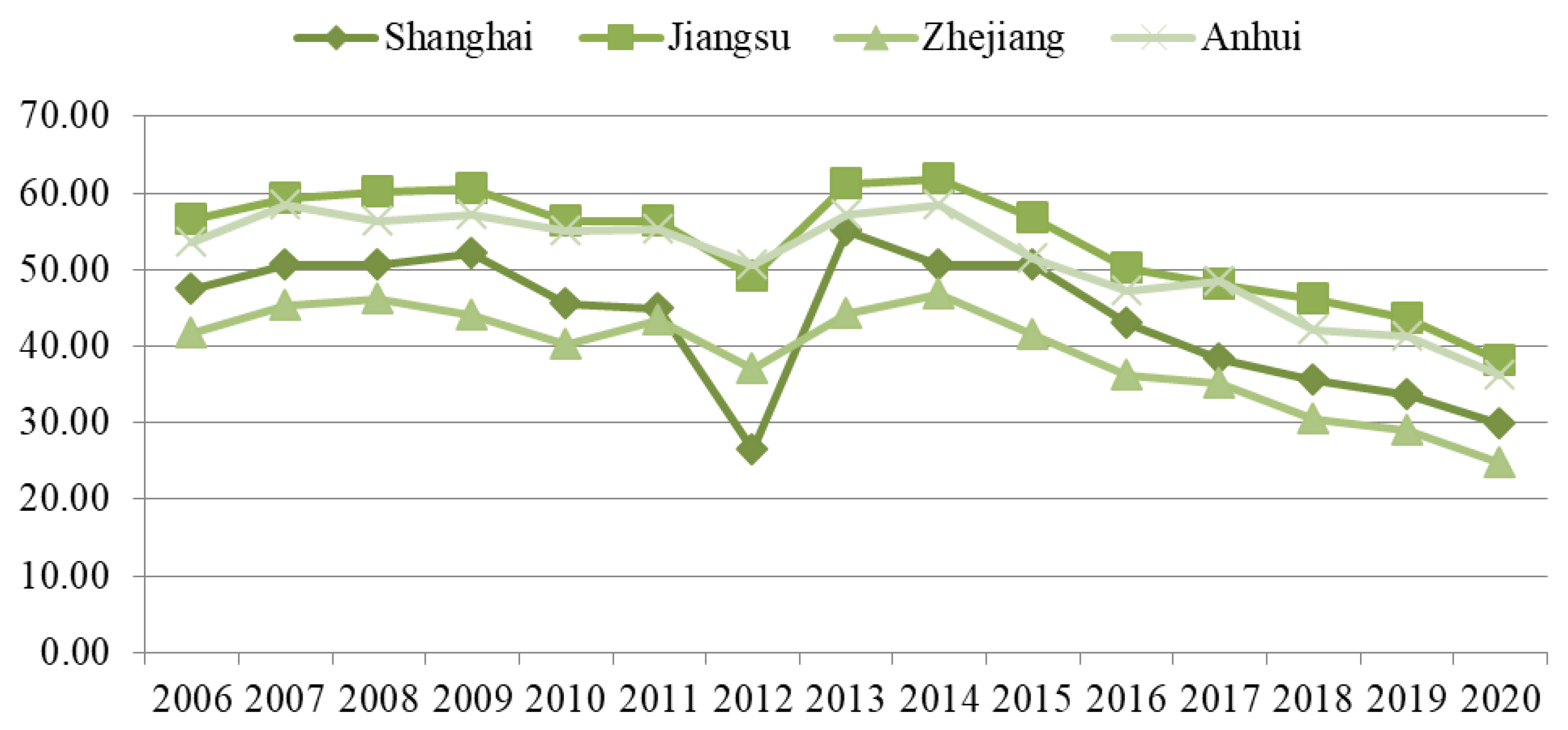
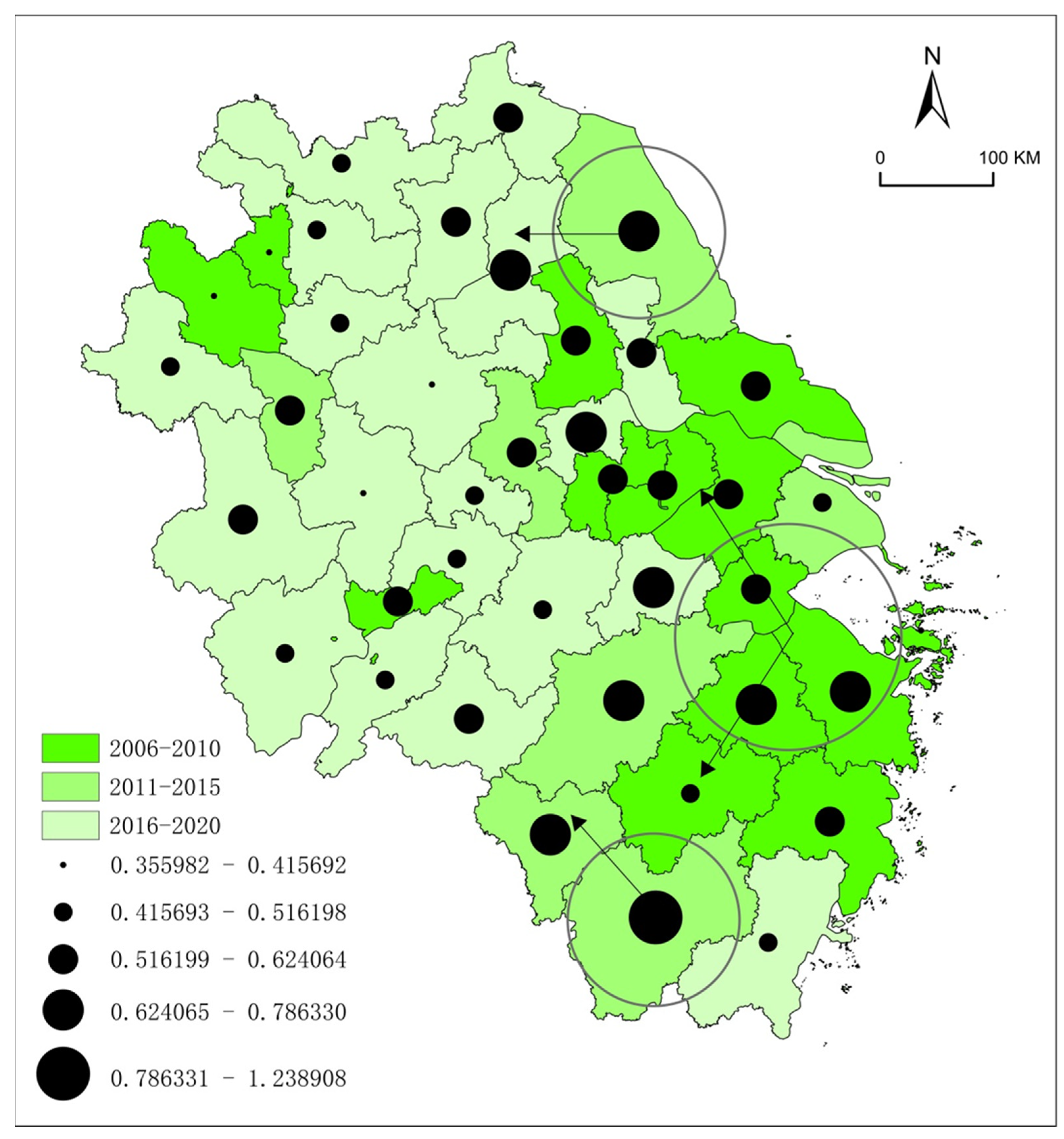
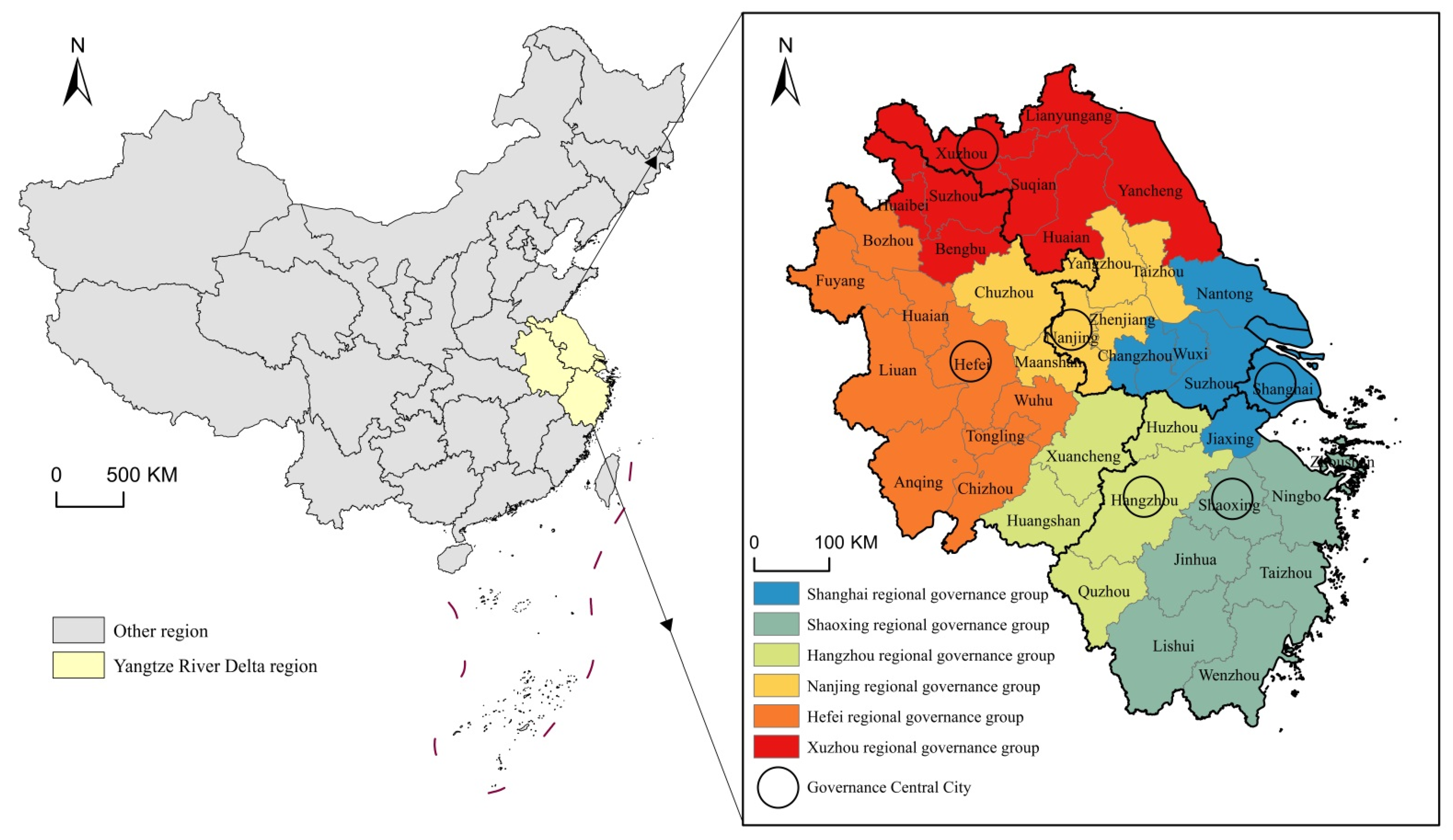
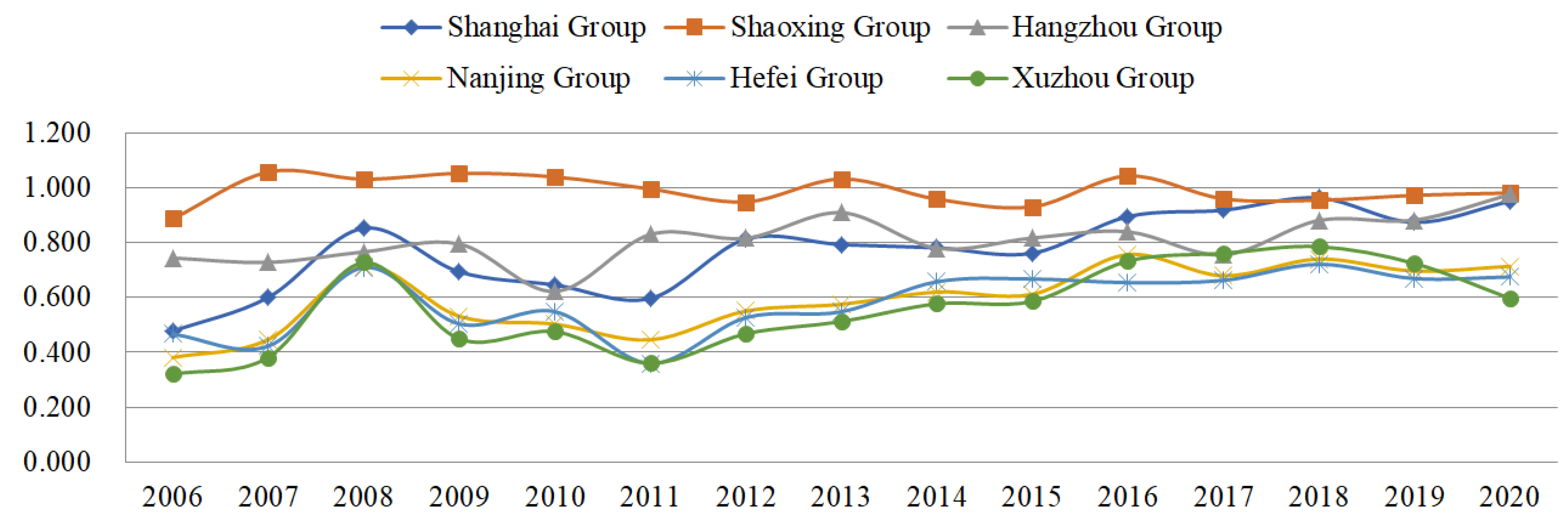
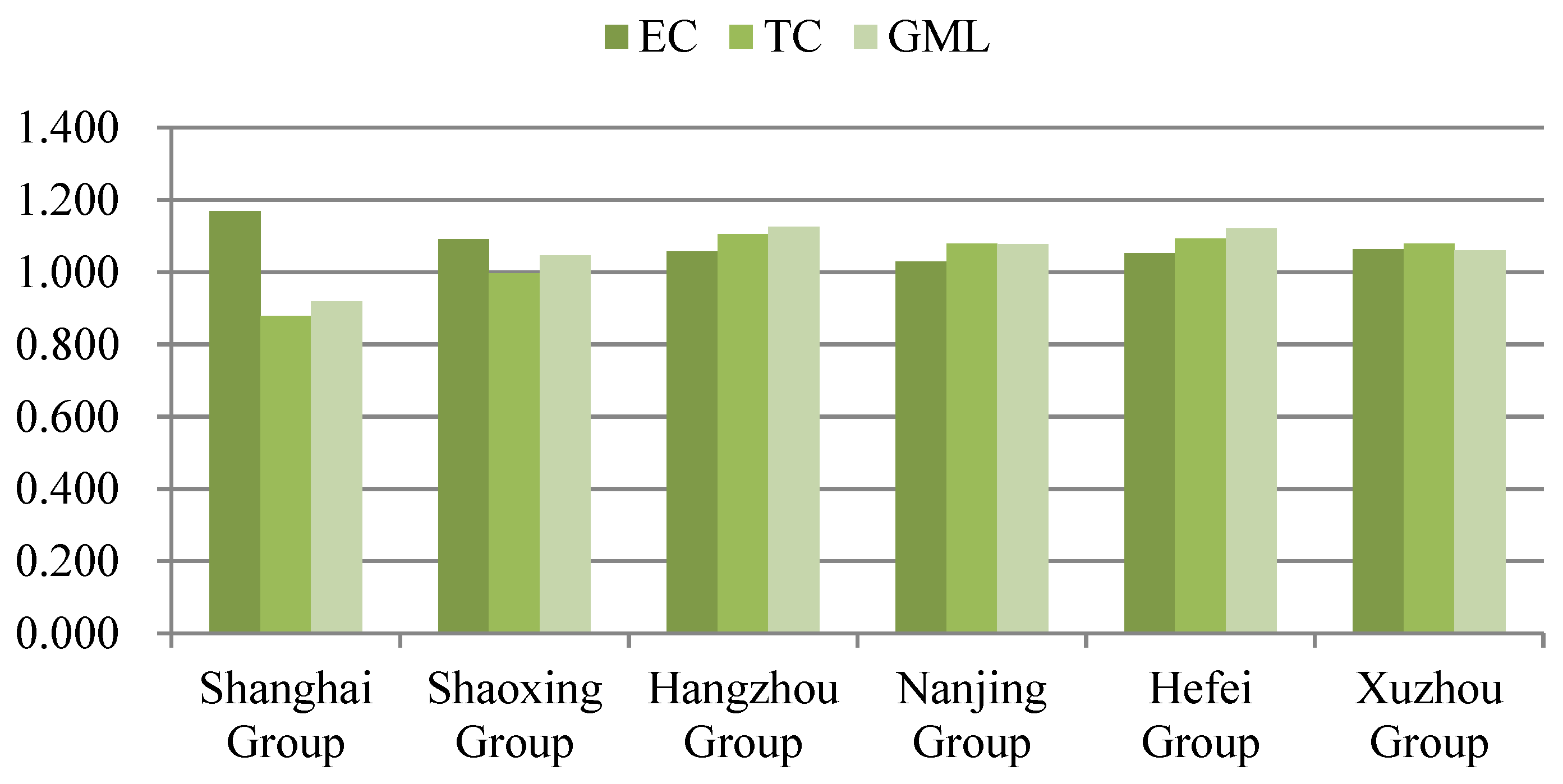
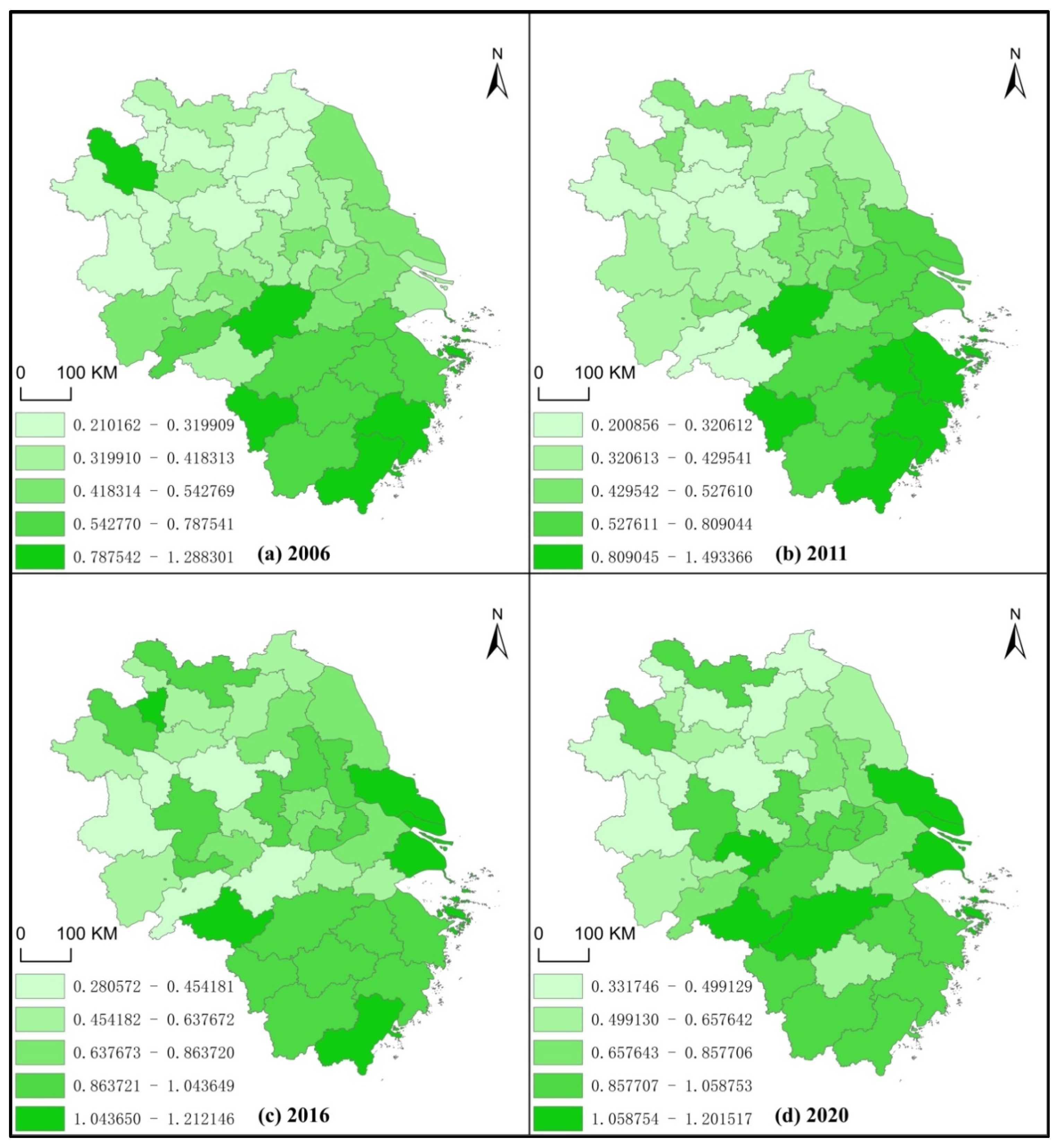
| Primary | Secondary | Tertiary | Indicator Variables |
|---|---|---|---|
| Input | Labor | The proportion of total employment in water, environment, public facilities management, and non-private employment (%) | |
| Capital | The proportion of investment in environmental pollution control relative to GDP (%) | ||
| Land | The greening coverage of built-up areas (%) | ||
| Output | Expected | Economic | The GDP produced per unit of CO2 emissions (billion CNY/million tons) |
| Ecological | The harmless domestic waste treatment rate (%) and the industrial solid waste treatment rate (%) | ||
| Unexpected | PM2.5 | Annual average concentration of fine particulate matter (PM2.5) (µg/m3) |
| IS | TP | IS*TP | ED | UR | TD | TE | PR | |
|---|---|---|---|---|---|---|---|---|
| Obs. | 615 | 615 | 615 | 615 | 615 | 615 | 615 | 615 |
| Mean | 0.4244 | 5.0136 | 2.2303 | 10.7422 | 0.5804 | 1.3707 | 16.2677 | 1.3160 |
| Std.Dev. | 0.0820 | 2.0023 | 1.2167 | 0.7515 | 0.1336 | 0.4976 | 0.7073 | 0.3708 |
| Min | 0.2340 | 0.0000 | 0.0000 | 8.2963 | 0.2453 | 0.5358 | 14.1942 | 0.5741 |
| Max | 0.7315 | 9.2697 | 6.6928 | 12.2011 | 0.8970 | 4.8317 | 18.0906 | 2.4998 |
| Province | City | Group | Average Score | Rank |
|---|---|---|---|---|
| Zhejiang | Wenzhou | Shaoxing regional governance group | 1.222 | 1 |
| Zhejiang | Zhoushan | Shaoxing regional governance group | 1.183 | 2 |
| Zhejiang | Quzhou | Hangzhou regional governance group | 1.077 | 3 |
| Zhejiang | Shaoxing | Shaoxing regional governance group | 0.975 | 4 |
| Zhejiang | Ningbo | Shaoxing regional governance group | 0.962 | 5 |
| Zhejiang | Taizhou | Shaoxing regional governance group | 0.961 | 6 |
| Zhejiang | Lishui | Shaoxing regional governance group | 0.95 | 7 |
| Jiangsu | Nantong | Shanghai regional governance group | 0.919 | 8 |
| Zhejiang | Hangzhou | Hangzhou regional governance group | 0.879 | 9 |
| Anhui | Xuancheng | Hangzhou regional governance group | 0.863 | 10 |
| Jiangsu | Wuxi | Shanghai regional governance group | 0.852 | 11 |
| Anhui | Bozhou | Hefei regional governance group | 0.826 | 12 |
| Shanghai | Shanghai | Shanghai regional governance group | 0.807 | 13 |
| Anhui | Hefei | Hefei regional governance group | 0.759 | 14 |
| Jiangsu | Nanjing | Nanjing regional governance group | 0.742 | 15 |
| Jiangsu | Suzhou | Shanghai regional governance group | 0.734 | 16 |
| Jiangsu | Taizhou | Nanjing regional governance group | 0.725 | 17 |
| Jiangsu | Yangzhou | Nanjing regional governance group | 0.719 | 18 |
| Jiangsu | Xuzhou | Xuzhou regional governance group | 0.706 | 19 |
| Anhui | Huaibei | Xuzhou regional governance group | 0.689 | 20 |
| Zhejiang | Jinhua | Shaoxing regional governance group | 0.682 | 21 |
| Anhui | Wuhu | Hefei regional governance group | 0.679 | 22 |
| Jiangsu | Changzhou | Shanghai regional governance group | 0.675 | 23 |
| Anhui | Tongling | Hefei regional governance group | 0.671 | 24 |
| Zhejiang | Jiaxing | Shanghai regional governance group | 0.663 | 25 |
| Anhui | Huangshan | Hangzhou regional governance group | 0.655 | 26 |
| Jiangsu | Yancheng | Xuzhou regional governance group | 0.636 | 27 |
| Jiangsu | Zhenjiang | Nanjing regional governance group | 0.615 | 28 |
| Anhui | Anqing | Hefei regional governance group | 0.603 | 29 |
| Zhejiang | Huzhou | Hangzhou regional governance group | 0.576 | 30 |
| Jiangsu | Huaian | Xuzhou regional governance group | 0.574 | 31 |
| Anhui | Fuyang | Hefei regional governance group | 0.537 | 32 |
| Anhui | Suzhou | Xuzhou regional governance group | 0.515 | 33 |
| Jiangsu | Suqian | Xuzhou regional governance group | 0.503 | 34 |
| Anhui | Maanshan | Nanjing regional governance group | 0.482 | 35 |
| Anhui | Chizhou | Hefei regional governance group | 0.466 | 36 |
| Anhui | Bengbu | Xuzhou regional governance group | 0.447 | 37 |
| Jiangsu | Lianyungang | Xuzhou regional governance group | 0.445 | 38 |
| Anhui | Liuan | Hefei regional governance group | 0.42 | 39 |
| Anhui | Huaian | Hefei regional governance group | 0.32 | 40 |
| Anhui | Chuzhou | Nanjing regional governance group | 0.306 | 41 |
| Period | EC | TC | GML |
|---|---|---|---|
| 2006–2007 | 1.053 | 1.075 | 1.060 |
| 2007–2008 | 1.166 | 1.004 | 1.103 |
| 2008–2009 | 1.124 | 1.017 | 1.038 |
| 2009–2010 | 1.098 | 1.064 | 1.066 |
| 2010–2011 | 1.049 | 1.003 | 1.020 |
| 2011–2012 | 1.018 | 1.064 | 1.037 |
| 2012–2013 | 1.060 | 1.094 | 1.074 |
| 2013–2014 | 1.056 | 1.026 | 1.026 |
| 2014–2015 | 1.152 | 1.008 | 1.119 |
| 2015–2016 | 1.065 | 1.045 | 1.050 |
| 2016–2017 | 0.986 | 1.067 | 1.016 |
| 2017–2018 | 1.028 | 1.008 | 1.013 |
| 2018–2019 | 1.102 | 1.073 | 1.124 |
| 2019–2020 | 1.104 | 1.043 | 1.111 |
| Mean | 1.076 | 1.042 | 1.061 |
| Year | Moran’s I | Z | p-Value |
|---|---|---|---|
| 2006 | 0.1106 | 6.2487 | 0.000 |
| 2007 | 0.1911 | 9.9349 | 0.000 |
| 2008 | 0.0427 | 3.0758 | 0.002 |
| 2009 | 0.1447 | 7.7435 | 0.000 |
| 2010 | 0.1133 | 6.2987 | 0.000 |
| 2011 | 0.1617 | 8.6148 | 0.000 |
| 2012 | 0.1158 | 6.375 | 0.000 |
| 2013 | 0.1355 | 7.2326 | 0.000 |
| 2014 | 0.0417 | 2.9969 | 0.003 |
| 2015 | 0.0338 | 2.6379 | 0.008 |
| 2016 | 0.0408 | 2.9558 | 0.003 |
| 2017 | −0.0054 | 0.9177 | 0.359 |
| 2018 | 0.0095 | 1.5536 | 0.120 |
| 2019 | −0.0001 | 1.1113 | 0.266 |
| 2020 | 0.0757 | 4.5024 | 0.000 |
| Variables | OLS (1) | SLM (2) | SEM (3) |
|---|---|---|---|
| IS | 1.251 *** | −0.205 | −0.219 |
| (0.398) | (0.469) | (0.470) | |
| TP | −0.0126 | −0.0877 *** | −0.0884 *** |
| (0.0286) | (0.0280) | (0.0286) | |
| IS*TP | −0.0243 | 0.116 * | 0.118 * |
| (0.0632) | (0.0679) | (0.0692) | |
| ED | 0.184 *** | 0.135 ** | 0.134 ** |
| (0.0347) | (0.0587) | (0.0586) | |
| UR | −0.454 *** | −0.163 | −0.166 |
| (0.171) | (0.293) | (0.294) | |
| TD | −0.0674 *** | 0.0439 | 0.0437 |
| (0.0226) | (0.0355) | (0.0356) | |
| TE | 0.0635 *** | 0.0294 | 0.0300 |
| (0.0162) | (0.0700) | (0.0699) | |
| PR | 0.0764 ** | −0.00110 | −0.000273 |
| (0.0318) | (0.0467) | (0.0468) | |
| Constant | −2.462 *** | ||
| (0.337) | |||
| Rho | −0.0839 | ||
| (0.185) | |||
| lambda | −0.0194 | ||
| (0.187) | |||
| sigma2_e | 0.0279 *** | 0.0279 *** | |
| (0.00159) | (0.00159) | ||
| LM | 13.70 *** | 106.75 *** | |
| LR | 63.62 *** | 63.82 *** | |
| Observations | 615 | 615 | 615 |
| R-squared | 0.319 | 0.188 | 0.190 |
| Variables | (1) | (2) | Variables | (3) | (4) |
|---|---|---|---|---|---|
| IS | −0.0564 | 0.166 | W*IS | 13.22 *** | 12.60 *** |
| (0.530) | (0.562) | (3.735) | (4.108) | ||
| TP | −0.100 *** | −0.0918 *** | W*TP | 0.876 *** | 1.038 *** |
| (0.0280) | (0.0300) | (0.222) | (0.248) | ||
| IS*TP | 0.108 | 0.0952 | W*IS*TP | −2.998 *** | −3.519 *** |
| (0.0684) | (0.0744) | (0.617) | (0.685) | ||
| ED | −0.0535 | 0.0300 | W*ED | −0.406 | −0.652 |
| (0.0686) | (0.0746) | (0.367) | (0.460) | ||
| UR | −0.0516 | −0.369 | W*UR | 2.952 | 0.494 |
| (0.290) | (0.314) | (2.620) | (3.024) | ||
| TD | 0.000213 | −0.00172 | W*TD | 0.169 | −0.0782 |
| (0.0355) | (0.0404) | (0.323) | (0.385) | ||
| TE | 0.121 | 0.0661 | W*TE | −0.274 | −0.320 |
| (0.103) | (0.106) | (0.450) | (0.470) | ||
| PR | 0.236 *** | 0.128 | W*PR | −1.003 *** | −0.331 |
| (0.0826) | (0.0906) | (0.331) | (0.349) | ||
| sigma2_e | 0.0249 *** | 0.0250 *** | Rho | −0.537 ** | −0.552 ** |
| (0.00143) | (0.00148) | (0.217) | (0.229) | ||
| Wald | 67.28 *** | 60.52 *** | Hausman | 29.81 *** | 37.63 *** |
| Observations | 615 | 574 | 615 | 574 | |
| R-squared | 0.188 | 0.084 | 0.188 | 0.084 |
| Variables | Direct (1) | Indirect (2) | Total (3) | Direct (4) | Indirect (5) | Total (6) |
|---|---|---|---|---|---|---|
| IS | −0.215 | 9.144 *** | 8.929 *** | 0.0139 | 8.570 *** | 8.584 *** |
| (0.554) | (2.648) | (2.618) | (0.587) | (2.878) | (2.837) | |
| TP | −0.113 *** | 0.644 *** | 0.531 *** | −0.107 *** | 0.746 *** | 0.639 *** |
| (0.0277) | (0.161) | (0.161) | (0.0297) | (0.177) | (0.179) | |
| IS*TP | 0.152 ** | −2.118 *** | −1.966 *** | 0.148 ** | −2.448 *** | −2.300 *** |
| (0.0678) | (0.466) | (0.478) | (0.0735) | (0.517) | (0.530) | |
| ED | −0.0476 | −0.255 | −0.303 | 0.0398 | −0.447 | −0.407 |
| (0.0698) | (0.270) | (0.244) | (0.0757) | (0.334) | (0.310) | |
| UR | −0.0828 | 1.848 | 1.766 | −0.370 | 0.258 | −0.112 |
| (0.270) | (1.808) | (1.834) | (0.289) | (2.024) | (2.066) | |
| TD | −3.64 × 10−5 | 0.103 | 0.103 | 0.00170 | −0.0661 | −0.0644 |
| (0.0341) | (0.216) | (0.216) | (0.0386) | (0.253) | (0.255) | |
| TE | 0.126 | −0.240 | −0.114 | 0.0718 | −0.252 | −0.180 |
| (0.113) | (0.338) | (0.252) | (0.116) | (0.351) | (0.264) | |
| PR | 0.249 *** | −0.760 *** | −0.511 *** | 0.131 | −0.266 | −0.135 |
| (0.0891) | (0.269) | (0.198) | (0.0970) | (0.279) | (0.199) | |
| Observations | 615 | 615 | 615 | 574 | 574 | 574 |
| Number of IDs | 41 | 41 | 41 | 41 | 41 | 41 |
| Variables | (1) | (2) | (3) | (4) | (5) | (6) | |
|---|---|---|---|---|---|---|---|
| IS | Direct | −1.51 | 5.381 *** | −2.153 | −0.481 | −3.277 ** | 3.402 *** |
| (−2.779) | (−1.774) | (−1.72) | (−0.882) | (−1.329) | (−1.151) | ||
| Indirect | 15.97 *** | 4.784 | 5.487 | 3.248 | 7.573 ** | 5.582 ** | |
| (−5.983) | (−5.11) | (−3.972) | (−2.648) | (−3.257) | (−2.606) | ||
| Total | 14.46 ** | 10.16 * | 3.334 | 2.767 | 4.295 | 8.984 *** | |
| (−6.432) | (−5.535) | (−3.31) | (−2.87) | (−3.562) | (−2.724) | ||
| TP | Direct | −0.181 | 0.454 *** | −0.135 | −0.0957 ** | −0.193 *** | 0.224 *** |
| (−0.141) | (−0.155) | (−0.0924) | (−0.0441) | (−0.0663) | (−0.0843) | ||
| Indirect | 0.972 *** | 0.221 | 0.485 ** | 0.0846 | −0.0858 | 0.642 *** | |
| (−0.282) | (−0.32) | (−0.205) | (−0.143) | (−0.163) | (−0.184) | ||
| Total | 0.790 *** | 0.674 | 0.349 | −0.0112 | −0.279 * | 0.866 *** | |
| (−0.288) | (−0.41) | (−0.226) | (−0.159) | (−0.151) | (−0.202) | ||
| IS*TP | Direct | 0.309 | −0.839 *** | 0.337 | 0.107 | 0.516 *** | −0.587 *** |
| (−0.33) | (−0.321) | (−0.229) | (−0.136) | (−0.161) | (−0.215) | ||
| Indirect | −2.460 *** | −0.284 | −0.651 | −0.347 | −0.451 | −1.706 *** | |
| (−0.649) | (−0.734) | (−0.492) | (−0.419) | (−0.445) | (−0.504) | ||
| Total | −2.151 *** | −1.123 | −0.314 | −0.24 | 0.0653 | −2.292 *** | |
| (−0.65) | (−0.88) | (−0.585) | (−0.461) | (−0.417) | (−0.522) | ||
| Observations | 90 | 105 | 75 | 90 | 135 | 120 | |
| Number of IDs | 6 | 7 | 5 | 6 | 9 | 8 | |
| Variables | Direct (1) | Indirect (2) | Total (3) | Direct (4) | Indirect (5) | Total (6) |
|---|---|---|---|---|---|---|
| IS | −0.364 | 5.349 * | 4.985 * | −0.167 | 7.263 ** | 7.096 ** |
| (0.536) | (2.947) | (2.927) | (0.563) | (3.248) | (3.226) | |
| TP | −0.0894 *** | 0.303 * | 0.214 | −0.0779 *** | 0.470 ** | 0.392 ** |
| (0.0282) | (0.168) | (0.170) | (0.0297) | (0.194) | (0.196) | |
| IS*TP | 0.121 * | −0.815 * | −0.694 | 0.0976 | −1.698 *** | −1.600 *** |
| (0.0686) | (0.478) | (0.493) | (0.0734) | (0.547) | (0.563) | |
| Observations | 615 | 615 | 615 | 574 | 574 | 574 |
| Number of IDs | 41 | 41 | 41 | 41 | 41 | 41 |
Disclaimer/Publisher’s Note: The statements, opinions and data contained in all publications are solely those of the individual author(s) and contributor(s) and not of MDPI and/or the editor(s). MDPI and/or the editor(s) disclaim responsibility for any injury to people or property resulting from any ideas, methods, instructions or products referred to in the content. |
© 2023 by the authors. Licensee MDPI, Basel, Switzerland. This article is an open access article distributed under the terms and conditions of the Creative Commons Attribution (CC BY) license (https://creativecommons.org/licenses/by/4.0/).
Share and Cite
Sun, Y.; Xu, B. Spillover Effects and Performance Optimization of Air Pollution Control Policies: Evidence from the Yangtze River Delta Region, China. Systems 2023, 11, 418. https://doi.org/10.3390/systems11080418
Sun Y, Xu B. Spillover Effects and Performance Optimization of Air Pollution Control Policies: Evidence from the Yangtze River Delta Region, China. Systems. 2023; 11(8):418. https://doi.org/10.3390/systems11080418
Chicago/Turabian StyleSun, Yanming, and Binkai Xu. 2023. "Spillover Effects and Performance Optimization of Air Pollution Control Policies: Evidence from the Yangtze River Delta Region, China" Systems 11, no. 8: 418. https://doi.org/10.3390/systems11080418






